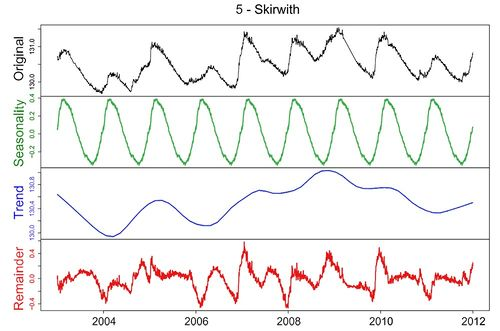OR/14/041 Data and methodology
| Lafare, A E A, Hughes, A G, and Peach, D W. 2014. Eden Valley observation boreholes: hydrogeological framework and groundwater level time series analysis. British Geological Survey Internal Report, OR/14/041. |
A summary description of the geological and hydrogeological setting of each borehole along with the groundwater hydrograph and its decomposition are provided in Appendix 1. Data from 26 observation boreholes (see Figure 2) obtained from the Environment Agency were used for this study. The purpose for the analysis was to improve the hydrological/hydrogeological conceptual model of the Eden Valley by better understanding the groundwater level responses and the causes of these responses. Since there are very limited data concerning the hydrogeology of the Carboniferous limestones and no time series of groundwater level measurements, the analysis was restricted to the Permo-Trias aquifers.
A standard set of diagrams were produced for each borehole (see the key provided at the beginning of Appendix 1):
- General location map
- Geological map (bedrock, quaternary deposits)
- Hydrogeological domain (map, and histograms showing the characteristics of the superficial deposits 1000 m and 2000 m from the borehole: no superficial, High permeability or Low permeability, thin 1 to thick 3)
- Geological log
It has to be noted that inconsistencies occasionally occur between the hydrogeological domain class and the information associated to the boreholes. For example the Scaleby borehole (number 6) lies within a cell of the domain map with the code 211 denoting relatively thin superficial deposits (less than 6 m), which is not consistent with the geological log indicating a till layer 13 m thick. The cell size (100 m x 100 m) of the domain map and the uncertainties associated to data such as superficial thickness maps can be cited as potential explanations.
This information was used to provide a descriptive interpretation of the area surrounding each borehole (see the boreholes summary sheets in Appendix 1).
Daily groundwater level time series are available from 18 boreholes for a time period between 2000 and 2012. For the remaining 6, only manual measurements (4–6 per year) are available. These hydrographs (groundwater level related to m AOD) are plotted alongside with the time series of the rainfall and an estimate of recharge (mm/day) obtained using the Eden Valley recharge model which used the BGS ZOODRM code (Mansour and Hughes, 2004[1]). The time series from the nearest model node to the borehole location have been plotted (see Appendix 1).
In order to better assess the groundwater level responses, a time series decomposition was performed for the daily groundwater level data using the Seasonal Trend decomposition by Loess (STL) method (Cleveland et al. 1990[2]; Shamsudduha et al. 2009[3]). Each time series, previously processed (extraction of the longest continuous period recorded, correction and filling of short gaps using interpolation, creation of time series characterized by a period of 365 days), was decomposed using the STL decomposition method in the R statistical language as:
- Where is the groundwater level at time t, is the trend component, is the seasona component representing for example the annual cycles, and is an irregular (remainder) component that can be related to short term variations (an example is provided in figure 4).

The STL method consists of a series of smoothing operations with different moving window widths chosen to extract different frequencies within a time series, and can be regarded as an extension of classical methods for decomposing a series into its individual components. STL uses the locally weighted regression (LOESS) technique that was first proposed by Cleveland (1979)[4] and later modified by Cleveland and Devlin (1988)[5]. The regression can be a line or a higher polynomial. The weighting reduces the influence of outlying points and is an example of robust regression. The nonparametric nature of the STL decomposition technique enables detection of nonlinear patterns in long-term trends that cannot be assessed through linear trend analyses (Shamsudduha et al. 2009[3]).
Based on the statistical dispersion of each of the components obtained after decomposition (trend, seasonality, remainder/short term variations) compared to the statistical dispersion of the original signal (as a percentage), relationships between the hydrogeological setting and the characteristics of the hydrographs are investigated. The variance of each time series component is calculated, as well as the ratio of this variance with the variance of the original signal. For example in the case of the trend:
_____________________
The variance of each component and these ratios are provided for each continuously measured boreholes in Appendix 1.
References
- ↑ Mansour, M M, and Hughes, A G. 2004. User’s manual for the recharge model ZooDRM. BGS internal report.
- ↑ Cleveland, R B, Cleveland, W S, MCrae, J E, Terpenning, I. (1990) Stl: A seasonal-trend decomposition procedure based on Loess. J Off Stat 6:3–73.
- ↑ 3.0 3.1 Shamsudduha, M, Chandler, R E, Taylor, R G, Ahmed, K M. (2009) Recent trends in groundwater levels in a highly seasonal hydrological system: the Ganges-Brahmaputra-Meghna Delta. Hydrol Earth Syst Sci 13:2373–2385. DOI:10.5194/HESS-13-2373-2009
- ↑ Cleveland, W S. (1979) Robust locally weighted regression and smoothing scatterplots. J Am Stat Assoc 74:829–836. DOI: 10.1080/01621459.1979.10481038
- ↑ Cleveland, W S, Devlin, S J. (1988) Locally weighted regression: an approach to regression analysis by local fitting. J Am Stat Assoc 83:596–610. DOI: 10.1080/01621459.1988.10478639